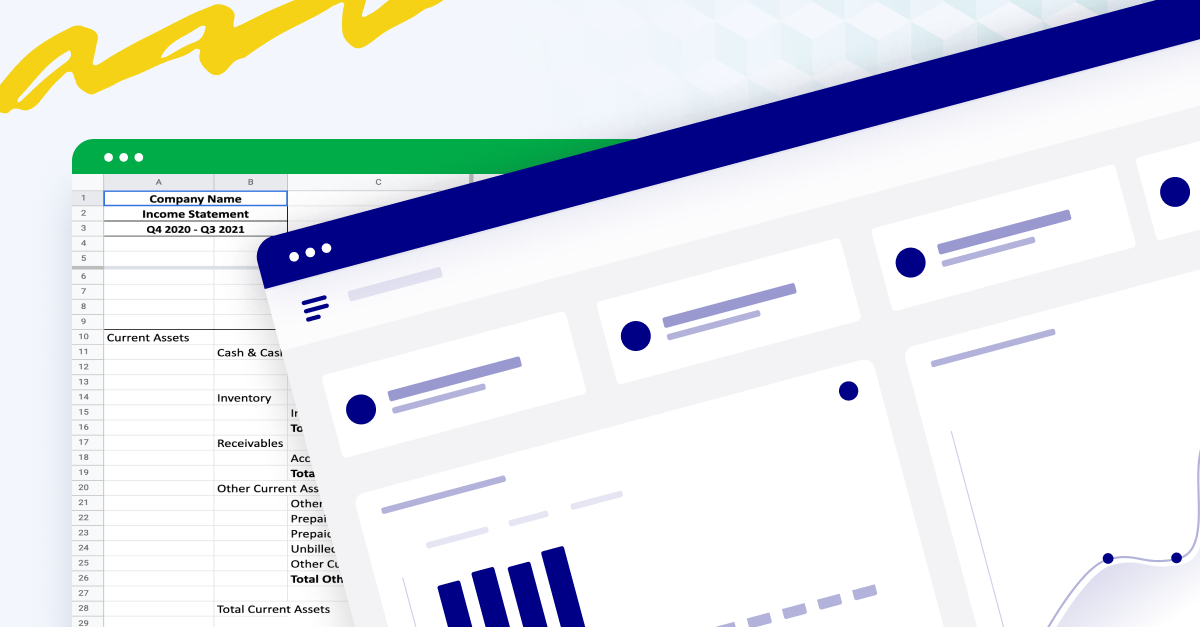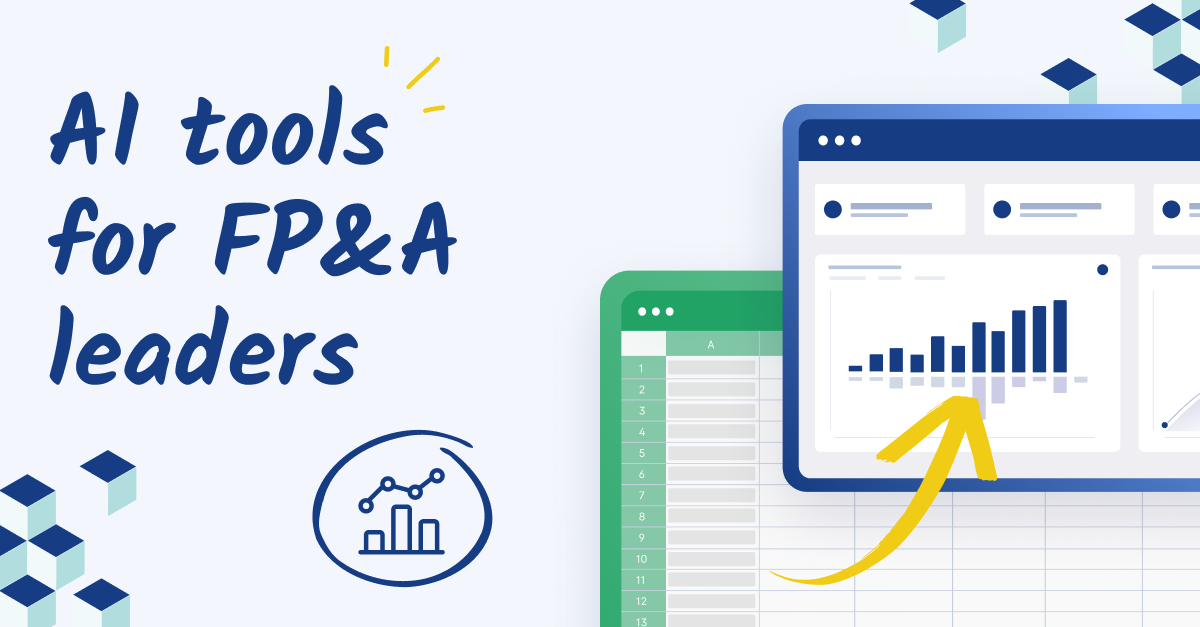The building blocks of strong FP&A
FP&A is a structured approach to financial planning, relying on four core components for success:
- Data collection and integrity
- Financial forecasting and modeling
- Budgeting and allocation
- Performance measurement
While modern FP&A supports these four pillars, it has the potential to add even more value to an organization. It can improve short-term outcomes, build credibility with stakeholders and investors, and drive business growth for the long term.
Adherence to sound financial planning practices builds a strong foundation for more progressive FP&A processes and techniques. Focusing on accuracy, thoroughness, and compliant practices outlined in Generally Accepted Accounting Principles (GAAP) and International Financial Reporting Standards (IFRS) is essential for building better systems.
From the starting point of good practice, finance leaders can be instrumental in improving three key areas—reporting, planning, and collaboration.

Advanced strategies for financial planning
Good FP&A goes beyond the basics, driving organizational growth through advanced techniques and strong organizational frameworks. When working toward improved planning, consider incorporating these practices into your process:
Operational data-informed planning
This strategic approach to planning and decision-making relies on utilizing operational data to inform and guide the planning process. It involves gathering, analyzing, and interpreting data from various operational sources within an organization to gain valuable insights and make data-driven decisions. The goal is to improve the efficiency, effectiveness, and overall performance of the organization by basing plans and actions on real-time and historical operational data.
Modern business generates a wealth of internal and external information. Using technology to harness those insights will greatly improve your forecasting and goal-setting endeavors. For example, using software for financial data analysis can give you access to insights from various types of operational data, including:
- Financial performance metrics
- Cash flow actuals
- Sales forecasts
- Customer segmentation data
- Pricing and cost analysis
- Market trends
- Competitive analysis
- Price benchmarking
Businesses that use big data as part of their planning process see more success than those that don’t. Despite this benefit, businesses report that up to 90 percent of their data is unstructured (i.e., lacks a predefined data model or organization). While AI and machine learning are improving the usefulness of this data, it can be hard for teams without these resources to glean needed insights from their data.
Risk management
Every opportunity has potential downsides, so risk management is an integral part of financial goal-setting. Good risk management reporting can help identify the potential risks in chasing an opportunity. A structured approach to risk management helps ensure the company meets objectives while minimizing potential impacts.
Key performance indicators (KPIs) and contingency planning are essential strategies for managing financial risk. These methods help businesses see potential issues in the roadmap and adapt quickly if challenges arise. Predictive analytics may also assist in goal setting, providing greater insight into potential risks affecting performance. With these tools, FP&A professionals can effectively mitigate risks and create more secure financial outcomes.
Data security is a crucial part of risk management. It ensures that companies maintain regulatory compliance and secures the integrity of their data. It also reduces the risk of costly breaches from internal or third-party bad actors. FP&A software offers detailed visibility, risk identification, fraud detection, and asset protection. Automated alerts notify admins about breaches for swift action against potential fraud or threats to data security.
Aligning short-term and long planning
Long-term success doesn’t happen on its own. It’s the product of many individual actions and decisions. For this reason, a long-term strategy must always align with short-term actions and operational processes.
Clear short-term planning ensures everyone knows what daily actions must occur to get desired results. Short-term objectives act as a compass to navigate changing conditions and financial pressures successfully. These short-term plans should be well-documented, communicated, and championed. This is where effective leadership becomes key, reiterating the message and supporting activities that lead to success.
Budgeting: beyond the basics
As businesses grow, the tools and methods they use for analysis must keep pace. By leveraging more advanced budgeting techniques, leaders open the door to stable growth and more opportunities. Your budgeting data (and what you do with it) plays a big role in your outcomes, starting with your budgeting method.
Advanced budget techniques
Companies moving away from a traditional budget often move to zero-based budgeting. It’s one of the four main approaches mature businesses use to establish budgets. This bottoms-up approach works by examining every budget line from zero. From there, every line item must be justified and allocated a separate funding source.
Zero-based budgeting allows for better cost control, provides more accurate financial forecasts, and encourages departments to think critically when allocating resources. It can help eliminate wasteful spending since each expense must be justified before approval.
Use technology for a better budget process
Technology has opened new doors for FP&A professionals. In addition to more robust budgeting techniques, FP&A software helps streamline the budgeting and forecasting process, giving teams access to more accurate and timely financial information.
It enables leaders to drill down into their budgets to fine-tune allocations with insight and confidence. This level of visibility helps them collaborate on the budget process, optimize spending, integrate other systems such as ERP and expense tools, and distribute budgets and financials with ease.
The change management approach to building new FP&A processes
Improving a finance process is a team sport. When moving from traditional methods to more advanced techniques, you may need to build support for the change—especially in long-established businesses stepping up their financial processes. A collaborative and well-structured change management approach may alleviate cold feet, getting everyone on board with better practices.
Follow these steps to ensure a smooth transition period for your business and staff:
1. Communicate the reasons for change
Team members undergoing process changes aren’t usually averse to change outright. More often, friction begins when understanding ends. Therefore, strong communication about the upcoming change (and the rationale behind it) is a vital first step. Encourage stakeholders to participate in the change process and contribute ideas and support to implementation.
One way to gain buy-in is to explain the value of an improved system. Sell the idea of improved visibility, faster access to financial information, fewer redundant tasks, and less manual work.
2. Outline the change process
Provide a roadmap for upcoming changes. Develop a timeline of expected implementation or cut-over dates, communicate what users and stakeholders should expect during the implementation period, and provide action items for staff assisting. Set deadlines for necessary action items and keep relevant users informed of progress, delays, or changes.
3. Support staff through the change
Once stakeholders understand the why, instill confidence in the how. Provide ample opportunities for training and direct support. Be sure every involved staff member understands how the new FP&A process works, what tools they will use to implement it, and where they can turn for answers to questions. Provide different types of training—webinars, in-person training sessions, digital documentation, or video resources—to ensure every staff member can learn in the way best suited to their needs.
4. Develop metrics to measure progress
While buy-in is one measure of success, building an enterprise performance management system will provide valuable data and insight into your new process and change management needs. What does success look like? New user adoption, average cycle times, exception rates, budget adherence, and other metrics showcase change outcomes. Define what’s most important as an outcome, and build key performance indicators (KPIs) around those requirements.
5. Seek feedback on new processes
Every change management process has its share of unforeseen issues and unexpected benefits. Move beyond the metrics and solicit feedback from your team on the daily experience of the new function or process.
Anonymized employee surveys are an excellent way to gain a clear view of how changes affect daily life. They highlight areas for improvement and add to the knowledge base by identifying unexpected improvements.
The role of technology in optimizing financial health
Cloud tech and integrated systems advancements in the past decade have made advanced finance techniques more accessible than ever. They allow small to medium-sized businesses to automate processes, enhance budgeting and forecasting, improve risk management, and safeguard the overall financial health of the company. The advanced analytics capabilities they provide give stakeholders access to deeper financial insights in less time.
AI, machine learning, and the rise of predictive analytics
As companies grow, they build more revenue. This progress allows them to invest in software and tools that take their forecasting, budgeting, and allocation practices even further.
Advances in artificial intelligence and generative computing are improving financial performance every day. Predictive analytics and machine learning are two cutting-edge options for finance teams looking to streamline budgeting and forecasting.
Predictive analytics uses historical data to identify patterns and predict future trends.
Machine learning takes predictive analytics even further by leveraging algorithms to adjust forecasting models in real time.
Finance departments leverage predictive analytics and machine learning to gain a more accurate picture of their financial performance and future potential.
Predictive financial models can be used to analyze large data sets and identify patterns that can help teams forecast future trends in the market, giving them an edge when it comes to budgeting and planning. Machine learning algorithms can then be deployed on top of these models to provide even greater accuracy, quickly adjusting forecasting models in response to market changes.
By leveraging these cutting-edge technologies, finance departments can create more accurate forecasts with less effort.
Scenario and sensitivity analysis in forecasting
What-if scenario planning helps finance departments assess the impact of assumptions or variables on their forecasts. It involves creating multiple models considering variables like revenue growth rate, cost of goods sold, and interest rates. Through testing different combinations, finance teams gain insights into market changes, enabling them to develop informed strategies and maximize chances for success.
Sensitivity analysis tests how changing a particular variable (an independent variable) in a scenario might impact the variable under analysis (the dependent variable), thus changing the outcome and desired results.
For example, a company launching a new product might use sensitivity analysis to understand how changes in the cost of goods sold (COGS) or revenue growth rate affect overall profits and losses. In testing different scenarios—with differing assumptions on these variables—the team can identify which scenario will provide the highest returns.
Performing this analysis, companies become better equipped to make decisions and understand the potential risks associated with an activity, product, or campaign.
Ensuring accuracy in financial models
Forecast models aren’t “set it and forget it.” It’s important to regularly refine financial models and challenge assumptions to ensure the accuracy and relevance of data. With fast-changing market conditions, forecasts based on outdated data can damage performance.
AI helps teams ensure accuracy in financial modeling by automating model validation and refinement processes. AI algorithms can detect patterns, identify outliers, and compare scenarios for more accurate predictions—tasks that would take hours manually. AI-driven predictive planning also reduces forecasting errors by rapidly incorporating new data. With tech-empowered analytics, companies gain an accurate picture of future trends to make informed decisions.
Variance analysis and performance measurement
Financial planning is often a moving target. The assumptions and conditions you use to build a plan may look very different at the time a plan goes into action. This causes changes between your actual and expected results. When these deviations occur, advanced finance teams use financial reporting and techniques to understand why.
Even when all goes well, you need performance measurement to understand the numbers and refine tactics. These are some of the most common tools FP&A teams use to achieve and maintain strong financial performance:
Root cause analysis
Simply put, root cause analysis looks at the underlying factors of variations in financial performance. Finance teams use root cause analysis to explain the difference between forecasted and actual results. It considers the outside factors (economic conditions, competition, industry trends) and internal factors (organizational structure, strategy) that lead to an outcome. This analysis approaches deviation research with data and uncovers opportunities and areas for improvement.
Balanced scorecards
Balanced scorecards measure financial performance by taking into account the four perspectives of a business. These include:
- Financial
- Customer
- Internal process
- Learning and growth
This scoring system balances non-financial performance indicators with traditional financial metrics. It helps corporate financial analysts gain a holistic view of performance.
Economic Value Added (EVA)
Economic Value Added (EVA) is an advanced performance measurement tool that evaluates the value generated from a business by subtracting its cost of capital from its net operating profit. EVA provides a metric for companies to assess and track their financial performance over time, taking into account both internal and external factors. It measures how well a company is creating value for shareholders.
Dashboards and data visualization
The best way to ensure strong financial performance is to measure continuously. Once-laborious data dashboards have vastly improved in the age of software and AI. With the right dashboard tools, FP&A teams can develop and run sophisticated reporting and analysis with just a few clicks.
Enhancing communication and reporting
Reporting processes shouldn’t be the sole task of an FP&A team, yet manual reporting swallows up a disproportionate amount of time in the day.
Streamlining and automating the reporting process is a valuable practice that pays time dividends far into the future. This allows your team to focus on value creation over just reporting and research.
Here are three ways to improve the reporting process:
1. Use audience-specific reporting
Non-finance stakeholders can benefit greatly from an FP&A team's insights, but effectively communicating those insights to them is often a challenge. With audience-tailored reports, finance teams can create easily-digestible visuals and reports that resonate with a non-financial audience. This lets the message of the analysis come across more effectively. Taking this approach with the right reporting tools improves the quality of conversations surrounding data and analytics and saves time in report-building for different stakeholders.
2. Automate the reporting process
Manual reporting takes time and increases the chance of errors. Fortunately, FP&A software has made most reporting easier to automate. Automation has many benefits, from improving data and insight quality to time and cost savings and error reduction. Automating reports frees up time for finance teams to focus on more strategic activities mentioned in this article such as advanced budgeting, training, and interdepartmental collaboration.
3. Use interactive reporting and real-time data
In a world of ever-increasing data, static reports quickly become obsolete. With automated reporting, finance allows real-time data use and interactive analysis. Dynamic reporting enables financial analysts to uncover real-time trends and patterns, informing investment decisions and anticipating changes in the business environment. It facilitates ad hoc reporting to find answers and make decisions based on the latest data.
Building and developing FP&A teams
The success of any FP&A activity doesn’t rest solely on the process or processing power; it relies on the skills and diligence of a well-trained, cohesive FP&A team.
Strong leaders are instrumental in the development of a successful team. A Chief Financial Officer, Controller, or Director of Finance must recognize talent, unify the team, and lead them forward with a shared vision. These leaders build trust, foster collaboration, and skillfully coach, mentor, and challenge their employees. Clear communication keeps everyone on the same page, meeting all team needs. Strong leadership unleashes a team’s potential and focuses it on achieving organizational goals.
Strategies for training FP&A professionals
Collaboration makes your finance team stronger. A blend of culture-building, skill-building, and mentorship can take your team from good to great. Consider these options for improving your education and culture within your finance team:
-
Share your knowledge: Establish a collaborative workplace environment encouraging team-building and idea-sharing. Collaborative online spaces help bring together remote or hybrid teams.
-
Build a learning library: Create learning resources such as tutorials, FAQs, and online courses to help employees develop their skills in FP&A. Be sure to create resources to meet the needs of different learning styles such as video, audio, text-based, and interactive resources. Designate peer work sessions and stand-ups to provide sharing opportunities.
-
Create mentorship: Establish an internal mentoring program to pair experienced professionals with new hires for knowledge transfer. This helps ensure new hires are up-to-speed quickly on processes and procedures.
-
Encourage continuing education: Provide employees opportunities to extend their skills through professional certification and coursework. It helps teams stay knowledgeable about current trends in finance.
-
Participate in the industry: Encourage staff to attend industry events such as trade shows and professional organizations to network with peers and experts in FP&A. Create a learning culture beyond the classroom and help staff build their spheres.
Building finance success beyond the finance department
Cross-functional collaboration is crucial for successful FP&A. Without it, processes and ideas become siloed, hindering meaningful insights. These siloes also make managing corporate finances more expensive through duplication and omissions.
Collaboration among different teams allows a unified view of the business, revealing blind spots and opportunities. It also enables quick adaptation and goal alignment with the organization's mission. By working together, diverse skills lead to innovative problem-solving.
Conclusion: the power is in the process
Building an effective FP&A process is not just a mere undertaking; it is a strategic imperative for any organization seeking to thrive in today's competitive and unpredictable business landscape. With a solid FP&A process in place, you can confidently guide your organization towards long-term success.
Want to learn how Cube can help you build a top-notch FP&A process? Request a free demo today.



.png)








![Best strategic planning software for CFOs [2025 review]](https://www.cubesoftware.com/hubfs/Strategic-Planning-Software%20%281%29.webp)
